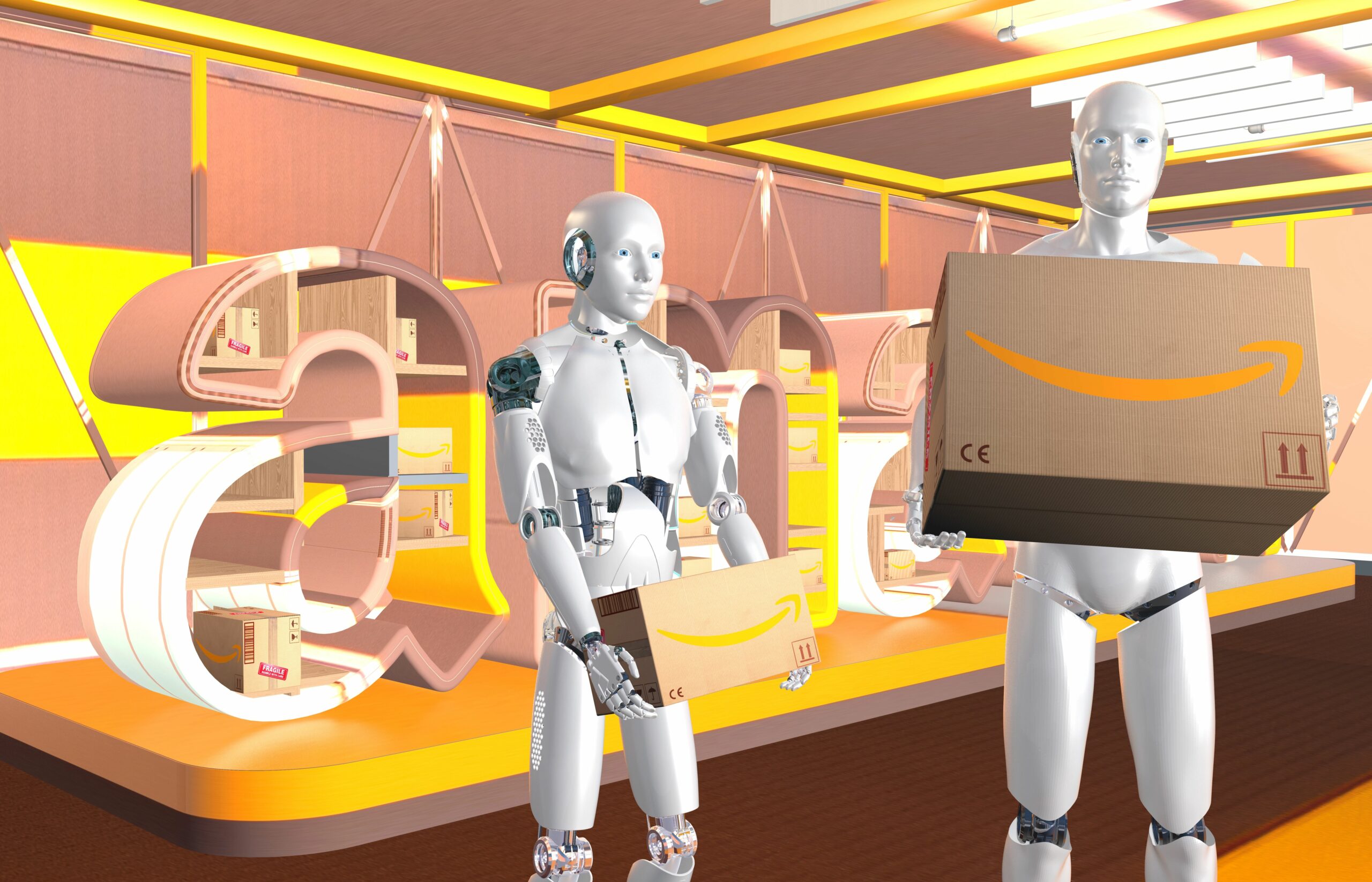
MikeMareen/Depositphotos.com
October 23, 2025
What Repercussions Will Result From Amazon’s Automation Push?
In an exhaustive Oct. 21 report from The New York Times, the publication outlined details tied to several Amazon interviews and internal strategy documents — with the thrust being that Amazon execs believe the company is poised to replace more than half a million (and potentially 600,000) workers with robotic equivalents.
“Executives told Amazon’s board last year that they hoped robotic automation would allow the company to continue to avoid adding to its U.S. work force in the coming years, even though they expect to sell twice as many products by 2033. That would translate to more than 600,000 people whom Amazon didn’t need to hire,” the publication’s Karen Weise wrote.
The retailer’s robotics team also allegedly holds a stated goal of automating 75% of its total operations, creating warehouses pertaining to its superfast deliveries facilities that employ very few human workers whatsoever. The documents appear to discuss avoiding words such as “automation” and “A.I.,” instead preferring terms such as “advanced technology” and “cobot” — rather than “robot” — to emphasize the nature of collaborative work alongside human employees.
For its part, Amazon is attempting to downplay the report first issued by the NYT, with The New York Daily News (via The Oakland Press) reporting that a company spokesperson offered a differing take on the allegations.
“Leaked documents often paint an incomplete and misleading picture of our plans, and that’s the case here. In this instance, the materials appear to reflect the perspective of just one team and don’t represent our overall hiring strategy across our various operations business lines — now or moving forward,” the spokesperson said.
It wasn’t made precisely clear by the New York Daily News whether the spokesperson in question was Kelly Nantel, whom the NYT cited as stating similar views as above, as well as plans for Amazon to hire 250,000 seasonal workers in advance of the upcoming holiday season.
Further, Amazon VP of Worldwide Operations Udit Madan signaled hopes that the role of the company’s human staff would evolve to fit the changing paradigm, with robots doing the “heavy lifting.”
“He’s claimed that the money the company saves from automation helps to create new higher-paying jobs, such as positions for robotic technicians. Madan said that since 2019, nearly 5,000 people have gone through Amazon’s mechatronics apprenticeship program, and that investing in upskilling its workforce is ‘something close to my heart,’ NYDN’s Brian Niemietz wrote.
Amazon’s Goodwill Initiatives: Tied to Potential Bad Press or Good Corporate Citizenship?
The NYT further implied that Amazon believes its massive push towards automation of work processes was so nearby, it had begun making plans to lessen the fallout in communities where jobs are threatened.
“Documents show the company has considered building an image as a ‘good corporate citizen’ through greater participation in community events such as parades and Toys for Tots,” Weise outlined.
By contrast, as Niemietz reported, Amazon did not agree with that narrative.
“A company spokesman told the Times that its alleged efforts to appear as a ‘good corporate citizen’ is unrelated to automation that may take jobs from the very communities it plans to engage.”
Further, company reps indicated that the entire premise of Amazon planning to essentially replace human employees with robotic workers was erroneous at its core.
“The facts speak for themselves: No company has created more jobs in America over the past decade than Amazon,” a spokesman told the NYDN.
Discussion Questions
Is the NYT’s reporting of Amazon’s planned push to automate about half of its workforce accurate, in your opinion? Why or why not?
Will Amazon’s goodwill efforts to mitigate pushback from jobs lost to automation be successful? What more can the company do to assuage concerns, and should it bother?
Will upskilling current labor positions into more technical roles play out as Amazon imagines?
Poll
BrainTrust
Oliver Guy
Global Industry Architect, Microsoft Retail
Shep Hyken
Chief Amazement Officer, Shepard Presentations, LLC
Doug Garnett
President, Protonik
Recent Discussions







Repercussions for whom? For Amazon, it will mean greater efficiency and cost savings, which can then be returned to shareholders, invested elsewhere, or used to help reduce prices. Amazon does have a competitive advantage because of its scale and innovative culture, but other retailers will implement their own forms of automation. For society, it means disruption – both in terms of jobs and the nature of work. How this plays out depends on policy choices and on new innovations that could generate replacement roles. The safety valve is that no retailer can afford to completely destroy demand by eliminating all jobs, as there would be no one left to buy things. The danger zone comes from an unequal impact and the rise of a more divided population.
Please pick up the white courtesy phone: K. Marx is on hold 4u. 🙂
I feel a red courtesy phone would be more appropriate!
The reporting by The New York Times that Amazon aims to automate roughly half its U.S. workforce raises valid concerns—but I believe the reality will be more nuanced. While Amazon clearly signals substantial automation ambitions (e.g., internal docs citing 75% operational automation by 2033) it also denies that these projections represent the company’s full hiring strategy. Automation will certainly reduce demand for some roles, but given Amazon’s scale, the change is likely to be incremental rather than sudden mass layoffs.
Amazon’s touted goodwill efforts—community outreach, technician apprenticeships, re-skilling programs—are necessary but likely insufficient on their own to mitigate the backlash. To truly assuage concerns, Amazon should transparently share workforce transition plans, guarantee upskill pathways with measurable outcomes, and partner with local economies to create alternative employment opportunities. Otherwise, skepticism will persist, especially in labor-heavy regions.
On whether upskilling current labor into technical roles will work as imagined: it will work in part, but the scale and pace may fall short. Amazon will create new jobs—automation engineers, robotics maintenance, data analysts—but many displaced workers may not easily transition into those roles. In contrast, Walmart’s framing as “people-led and tech-powered” reflects a different philosophy: they emphasize human roles supported by technology, rather than replacing humans wholesale. That model may prove more resilient in balancing automation gains with human employment continuity.
Clearly this is not just an Amazon issue. Amazon is just the one saying it out loud and giving the world notice that the metamorphasis of the workplace is about to happen…big time. I personally am hoping that Amazon manages this in a slow, orderly, evolutionary manner. There’s just no point in rushing it. It’s going to happen, but mitigating the downsides is going to be important in lots of communities. I’d love to read more about the list of “higher paying jobs” that this wave of automation will produce. So far the list has ‘robot technicians’ at the top of the list. What does the rest of the list look like?
Well yes, of course the reporting is accurate – in the sense that’s Amazon’s plan – the real question is will that materialize? Probably…at least to some extent (and probably not 100%, since no plan is ever 100% prescient).
The more important issue tho isn’t the 600K not-once-and-future Amazonians – even Amazon, mighty as it is only represents a sliver of the workforce – it’s that this will be multiplied across many companies. Automation isn’t new, and historically it hasn’t resulted in mass unemployment, whether that will remain true in the future I don’t know.
(And to clarify, I believe the claim is that number is those who won’t be hired, not current employees let go.)
At Amazon and elsewhere, upskilling is non-negotiable as AI modernizes industry paradigms and talent flow.
Earlier this year, Andy Jassy stated jobs will change due to GenAI and agents: “We will need fewer people doing some of the jobs that are being done today, and more people doing other types of jobs.”
The war on human beings continues. The critical missing element in the idea of automation is that it fails to comprehend the entirely unique, impossible to replicate abilities of human beings. It’s no surprise, today, that the digerati cannot comprehend human truths. Yet it remains sad that too many executives come to believe human beings are replaceable. Thus, Rory Sutherland notes how often it is forgotten that the human abilities of a doorman are of incredible economic value to companies — yet we are often told to simply get automated doors. Amazon appears to be lost in its own inability to comprehend the value of human beings. Automation and robots are the common response — something I discussed in a blog post “Are Robots A Way to Avoid Critical Business Decisions. I suspect this announcement is for investor ears — yet it indicates Amazon is incapable of comprehending its own complexities.
https://www.douggarnett.com/big-data-and-technology/is-enthusiasm-for-ai-driven-robots-a-way-to-avoid-the-truly-critical-business-questions/
The public is going to scream bloody murder when humanoids carry boxes to their front door.
Needed that:)
The NYT reporting is accurate because it matches Amazon’s consistent strategy of systematically eliminating human labor through technology at every opportunity: labor can demand raises and go on strike; robots cannot. The jobs being automated are specifically chosen because they’re repetitive, low-skill, and high-volume. The replacement roles are specialized, technical, and minimal in number. Meanwhile, Walmart is taking a different tack, augmenting human judgment rather than replacing it with technology. While Amazon is singled out for its scale and aggressiveness, society’s challenge is whether we need a different contract when technology enables concentrated productivity gains while distributing employment losses broadly.
This is any business doing smart business. Companies have been looking for efficiencies since the beginning of time. When Henry Ford did his “magic” with the the moving assembly line, people complained about job losses. Anytime an industry becomes obsolete, there are job losses. I will admit automation and AI may exacerbate the issue, but somehow it works out.
Amazon sells at competitive prices that customers love. To continue doing so, they must streamline their operations.
As for goodwill in the community, one should have nothing to do with the other, but no doubt customers do enjoy doing business with companies that “give back,” especially to causes in their local communities.
Transition is continuous process of improvment.
Automation is a core, inevitable business strategy driven by the need for efficiency and competitive pricing. A company’s duty is to its business model, not to permanently guarantee every job function. The real discussion point is not if Amazon automates, but how responsibly they manage the workforce transition. Their investment in upskilling is essential, but they must provide stronger, more transparent guarantees for displaced workers. What specific, mandated support should companies of this scale provide to ensure a successful transition?
This is interesting in relation to the future of work. It is worth looking at this in the context of Mustafa Suleyman’s book – The Coming Wave.
History has shown that when new technology appears it can displace humans for a time but it increases benefit over time… compare the number of people working in agriculture 150 years ago with today and then also compare the output.
However, caution is needed – workers will be concerned. Upskilling will be needed as is community engagement and a transition plan – one would hope the human labour can be redeployed to activities that only humans can do.
This will be interesting to watch – Amazon’s cost savings will benefit shareholders and should allow them to grow their business – competitors should only watch for a short while or they may not be in a position to watch anymore.
Automation is an inevitable and necessary part of progress, and companies like Amazon must pursue it to stay competitive. And as someone pointed out, they are saying out loud what many other companies are thinking. The key is ensuring that innovation doesn’t leave people behind so investment in reskilling and thoughtful workforce transition must advance at the same pace as the technology itself (although the new jobs created may not offset those eliminated).
When we introduced robotics to a major retailer, the employees we trained to work with the robotic systems said it was the best job they’d ever had at the retailer.